
半導體外商的小小螺絲釘,遊走於廢青與社畜之間。熱愛閱讀,喜歡透過書本探索外在、內化自我。希望藉由書寫打開與世界交流的一扇窗。 個人部落格:https://maxjamesread.com/
"Flexible Habits": The third-order goal method will help you overcome inertia and develop good habits!

How to form a habit is probably the most desired thing for many people, which is evident from the fact that "Atomic Habit" tops the rankings of various bookstores. But that means building habits can be a tough task. Thousands of men and women promised to exercise every day and read every day, but they always failed, and in the end they could only lament how difficult life is.
The book "Resilient Habits" that I want to talk about today is an attempt to break this endless cycle. Author Stephen. Gasth wrote another best-selling book , "The Power of Amazing Habits," which advocates the use of "micro" actions to create habits, and this book can be said to be an evolutionary version of it.
In the book, the author proposes that the key to forming a habit is " flexibility ". Habits are hard to sustain because our goals are too rigid. So he developed a "flexible habit", and as long as he designed his actions in this way, he could master the habit.
Below I will talk about why habits need flexibility, then explain how to design flexible habits, and finally share my six or seven months of implementation examples and experiences.
[Building a habit requires flexibility]
Everyone's path to failure in habit formation is probably very similar.
At first, he was always full of arrogance. He went to the gym every day or studied English hard, and worked hard to achieve his goals, but his enthusiasm continued for a while and then he was unsatisfactory. It might be because he suddenly worked overtime, or quarreled with another partner and felt depressed. It broke, and never picked up again. In the end, I complained about my lack of self-discipline and lack of determination.
We always think that self-discipline brings freedom, but the author says that on the contrary, freedom can bring self-discipline . Hard goals, such as doing 100 push-ups or memorizing 20 words a day, will blame yourself for failing to achieve them and damage your confidence.
So the goal is to be flexible. As Bruce Lee said, "Be Water, My Friend." Only like water, it can freely adapt to all kinds of cloudy, sunny, and sunny in life. How to do it? Let's start with small habits.
No one is able to walk completely on their expected path in life, and deviating from one's wishes is the norm rather than the exception.
- "Flexible Habits"
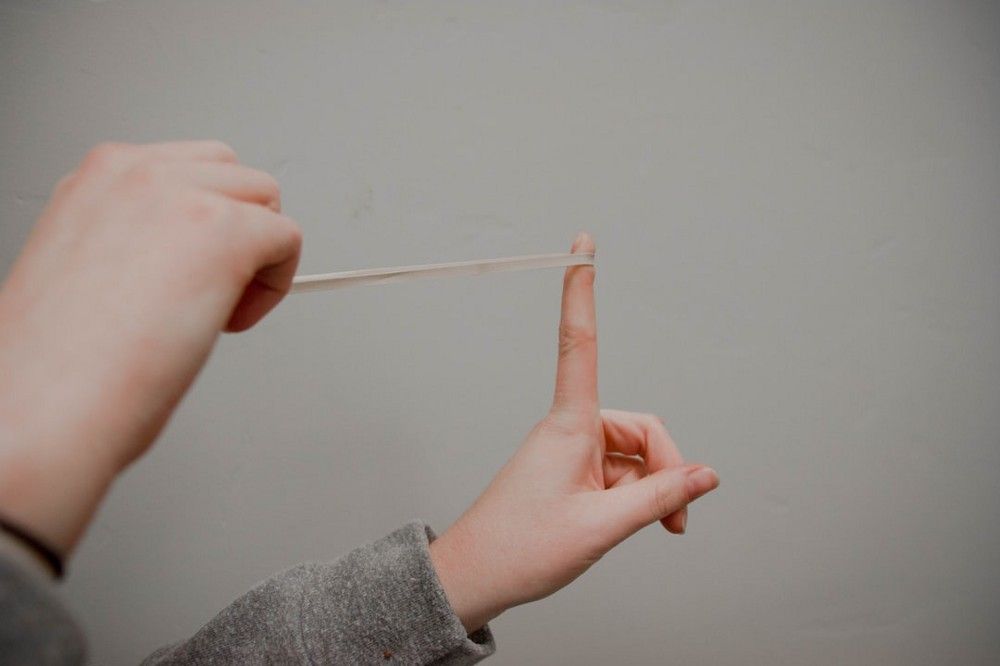
[Small Habits: Small Actions, Big Results]
In view of the fact that the biggest enemy of developing a habit is the unfinished self, the author advocated the use of "small habits" to achieve goals in the previous work "Amazing Habit Power" .
Instead of setting up a difficult action like doing 100 push-ups a day, try to minimize your goals first, such as doing 1 push-ups a day, reading a book for 1 minute, or reciting 1 word. The point is to keep the action threshold as low as possible so you can still get touchdowns when things aren't going well.
These little habits may seem innocuous and even stupid to execute, but they are very powerful. Because it keeps your inertia so the rolling ball doesn't stop. Of course, you can do more if things are good. As long as you persevere, keep the bottom line every day, challenge yourself occasionally, and gradually get used to it!
But sometimes, we still want more. Doing a little more in good times is still too general, and we need a more effective strategy, which is the essence of this book: resilient habits .

[Flexibility Habits: 3rd-Order Target Method]
The author admits that although small habits are great, such an architecture is still not flexible enough. So he came up with Little Habits 2.0, also known as: Elastic Habits . I summarize it as:
3 Habits X 3 Horizontal Options X 3 Vertical Targets.
Let's take a look at what these 3 items represent:
[3 Habits]
First, choose three habits that you want to develop. The authors suggest picking from your cherished values to identify the habit areas you most desperately want to develop. For example, "exercise" or "writing" are very suitable projects.
[3 horizontal options]
Then set 3 horizontal option goals for each habit to give yourself more flexibility in choosing. For example, the habit of exercise can be extended to many parallel movements, such as running in the park, retraining in the gym, or training with bare hands at home.
Some habits can be derived from many level options, but the author recommends picking 3 more, too many choices will make you choose obstacles.
[3 vertical targets]
After setting the horizontal axis, the next step is to set vertical goals of 3 different levels of difficulty. The author refers to these tier 3 goals: Mini , Advanced , and Elite . They are briefly described as follows:
- Mini <br class="smart">Mini goals are the little habits mentioned above. Criteria are activities that can be done easily, preferably less than 1 minute.
- ADVANCED <br class="smart">Advanced goals can be set into actions that you think would be admirable. The time is about 10-20 minutes.
- Elite <br class="smart">Elite is the high standard of self. You can ask yourself: "What goals would you feel great to accomplish?" The time can be set at 30 to 60 minutes.
These settings are very personal. One person's elite goal may be someone else's progression or even a mini-goal. But that doesn't matter, the point is to set the appropriate action according to your own conditions.
Just as water has no fixed shape, so does war have no fixed situation; those who can adjust their tactics according to the enemy's situation and win can be said to be born generals.
-grandson
With 3 Habits X 3 Horizontal Options X 3 Vertical Targets, we have a very systematic and flexible target option to execute. Allows you to flexibly adjust according to daily conditions. If you are not in a good mood, make a small habit. You can complete the advanced level if you have a little spare time. One day when you are full of fighting spirit, you will challenge the elite.
After reading it, you may still feel a little abstract, and then I will use my two-month practice as an example to talk about how to operate.

【My Flexible Habit Implementation】
First to admit that I didn't quite follow the 3X3X3 approach described above. In the two areas of health and learning, I have selected a total of 6 habits to practice and develop, namely meditation, stretching, exercise, sleep, reading and writing (pictured below).
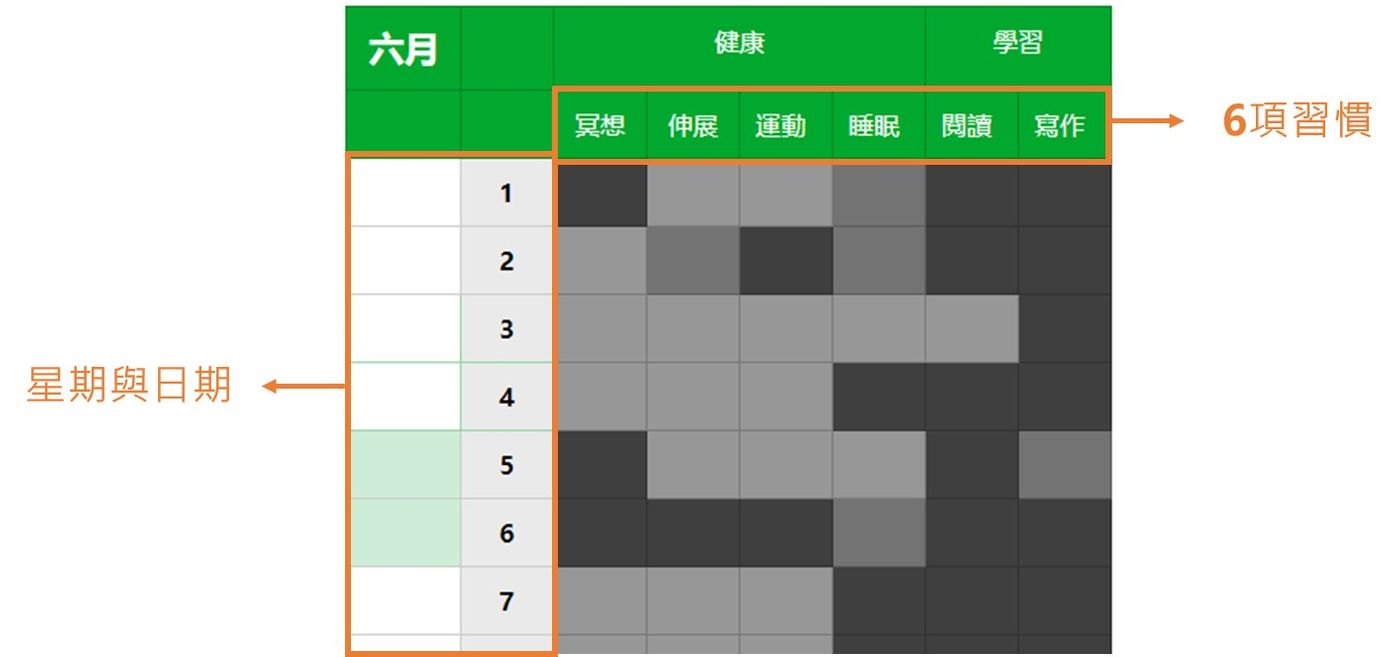
Then I used different shades of color to represent the 3 vertical targets, from light gray to dark gray to represent mini , advanced and elite respectively.

Then set horizontal and vertical goals for each habit. Take reading and exercise as examples. The level options for exercise I simply cut into upper body, lower body and core. For the mini part, choose movements that can be done in 1 minute (20 push-ups, 20 freehand squats, and sticks), and for advanced and elite groups, just increase the number of sets and movements. In addition, because going to the gym and playing basketball will definitely take more than 30 minutes, we will divide it into another area to the elite.
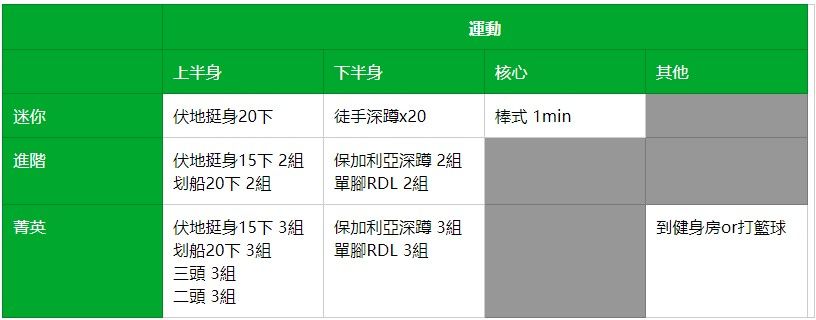
Taking reading habits as an example, I divide it into two horizontal directions: reading online articles and books, and the vertical target is defined by the number of articles and time.
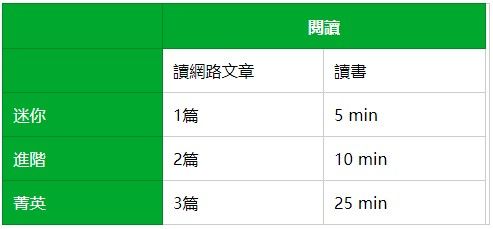
The book recommends reviewing the achievement of goals in two weeks, so I added a review column under two weeks:
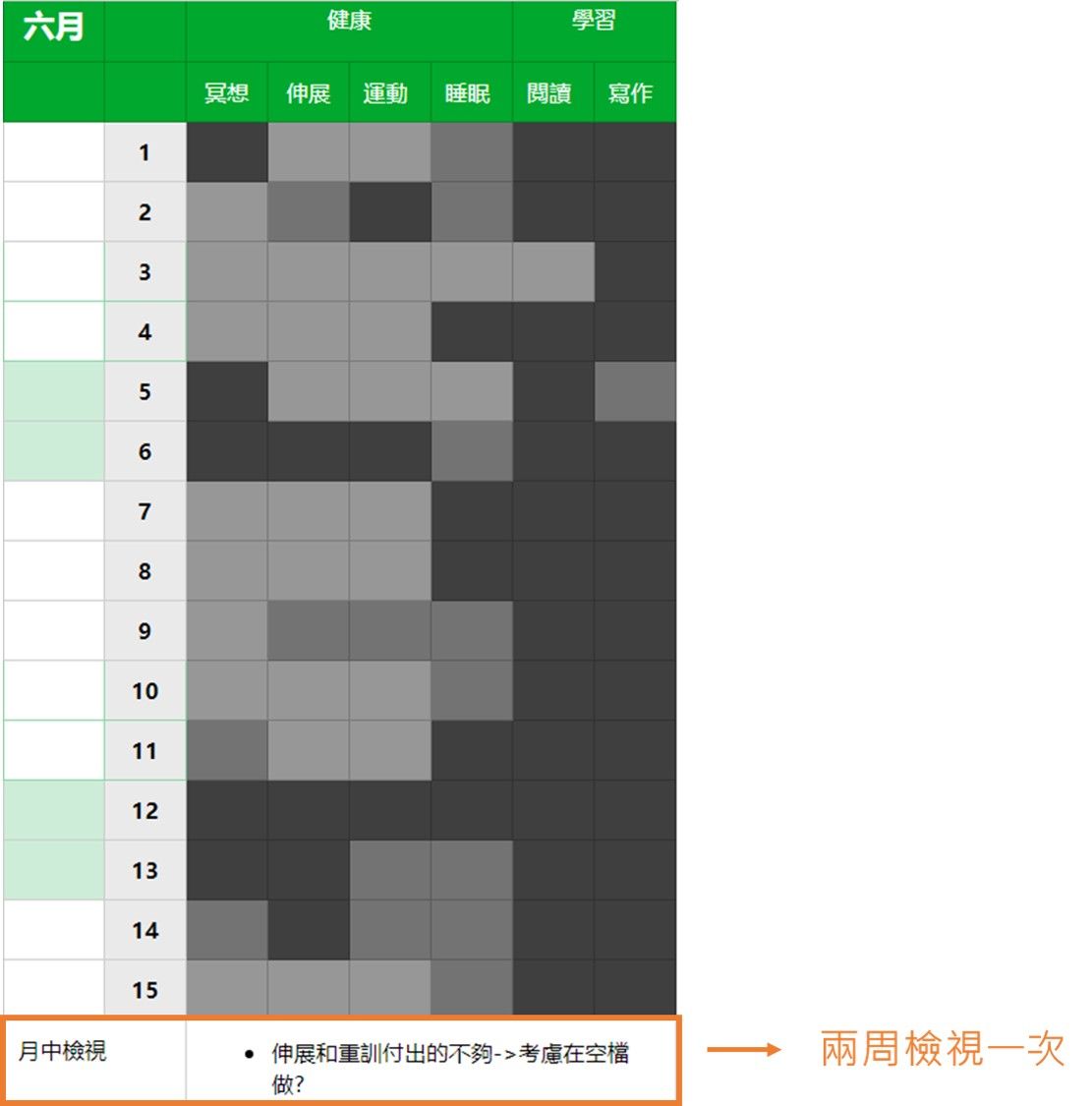
Finally, I would like to share my experience in the past two months. To be honest, the situation in the picture above (the first half of June) is almost copied and pasted in the back. Most of the reading and writing can reach the elite level. The conditions of meditation and sleep were more even, and all three vertical goals appeared.
The weaker part is stretching and movement. Because of the epidemic, my beloved cannot play basketball, nor can I go to the company gym. Then obviously, my self-training at home is not very effective (laughs). A lot of times it's as simple as doing 20 pushups or squats. However, I believe that as the epidemic slows down, the situation should improve (?)
Although I am not very satisfied, there is still an unexpected harvest, that is, the effect of the mini-action has been discovered. To be honest, I have seen the saying of small habits before, but I have no intention of practicing it. I feel that such a small action can have any effect. But in the process of this practice, I found that small habits can keep myself in a forward mentality, and this feeling of "uninterrupted" is indeed very helpful for habit formation.
In addition, although the effect of micro-retraining is not very good, my muscle sensitivity is maintained because of it. In the past, because of the short-term burst of overtime work, the retraining was completely abandoned. When you're done, go back to training, and it will take a while to get back to the previous state. But this time it didn't feel that way.
In general, these three-level action modes do provide great flexibility, allowing oneself to maintain forward momentum regardless of weather conditions, without any sense of interruption; and the horizontal axis makes the execution of actions not so rigid and boring. Keep the action fresh. It has to be said that elastic habits are indeed a feasible and easy-to-operate architecture.
【Summarize】
Summarize the above. First of all, it is necessary to understand that the failure of habits is often because of the lack of flexibility in the goal, and it puts too much psychological pressure on yourself when you cannot achieve it; and a small habit is a protective umbrella that can help you reach your goals even if you are not in a good state; finally, flexible habits are more advanced The ground use 3X3X3 mode, allowing you to adjust according to the situation.
By the way, this book is the first book donated by the publishing house in my life, and it can also be regarded as a milestone in my life!
I think the whole book is very smooth, and it also provides a lot of details and examples of mentality and operation. In the process of implementation, I also went back and checked the content of the book many times before I designed a model that suits me. It is recommended that you refer to the methods in the book, and then adjust according to your own situation.
After all, the method belongs to others after all, and only practice can achieve self!
Articles you may also be interested in:
If you guys liked this post, please help me clap your hands on Appreciating Citizens ! If you have any ideas, please leave a message and tell me!
Like my work?
Don't forget to support or like, so I know you are with me..
Comment…